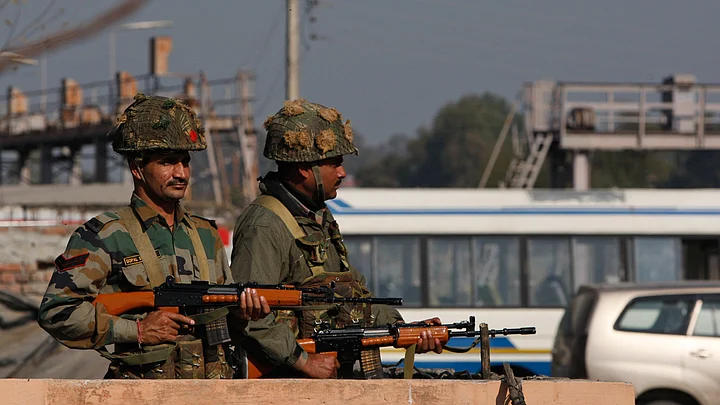A major disaster inside the Pathankot Air Force Station was averted early on Saturday due to an alert sounded by Indian intelligence agencies, following the abduction of a Punjab Police officer of SP-rank the previous day, who was later freed under mysterious circumstances. In another related incident, the same group of gunmen had also killed the driver of a car in the area.
Given the modus operandi adopted by terrorists from across the border in the past, including the use of the Olive Green (OG) uniform usually donned by army personnel and hijacking vehicles, intelligence agencies were prepared to face an attack in the area. Anyway, the IAF’s Pathankot base was among the most likely of targets, since the assault on the police officer was in the same range.
Thus, when the suspected Jaish-e-Mohammad terrorists mounted the attack in the wee hours of Saturday, security agencies were prepared and shot dead five of them within a few hours.
Abducted Officer Under Scanner
Intelligence agencies are, however, intrigued about the abduction and subsequent release of the SP, an unlikely scenario given the past actions of attackers. One would remember that they killed a shop owner and a driver in the Dinanagar attack and were aiming to hijack a bus and blow up railway tracks to cause maximum damage. The agencies, sources say, are finding it difficult to believe that the terrorists would let go a ‘major catch’ which would have earned them some brownie points with their handlers across the border.
The SP, Salwinder Singh, who was transferred from his post of SP Gurdaspur to that of Assistant Commandant, 75th batallion of Punjab Armed Police (PAP) a couple of days back, has claimed that he had gone to offer prayers at the samadhi of a peer baba near the border. He was accompanied by a jeweller friend, Rajesh Verma, and a personal attendant, who were also later thrown out of the official vehicle hijacked by the terrorists.
However, his version is being doubted by the security agencies. They suspect there’s more behind his presence near the border and are questioning him on his movements, even though they rule out his involvement with terrorists. It is significant to note that he was transferred on the basis of a complaint received against him.
Links Across the Border
Intelligence sources say that, like in the case of the Dinanagar attack, the attackers have left little evidence of their links across the border. However, intelligence agencies have been able to intercept some calls made by them to Bhawalpur before they were killed. Sources said that in one of the intercepted calls, one of the fidayeen was heard talking to his mother in a Punjabi dialect spoken in Pakistan.
Incidentally, the Border Security Force (BSF) and the Punjab Police have different views on how the attackers entered the country. While the Punjab Police claims that they entered from somewhere near Dorangla in Punjab, BSF personnel claim that they had entered from the Jammu border.
Meanwhile, the Punjab Police has declined to hand over the investigation to the NIA or any other central agency. It has constituted its own SIT.
Operation Monitored by NSA
Alerted by the SP’s abduction, a formation of the National Security Guard (NSG) had already landed in Pathankot on Friday night. As the attack on the base unfolded, the operation was closely monitored by the NSA, Ajit Doval.
The gunmen who must have aimed to destroy or damage some aircraft could not gain access to the hangers or the tarmac. The Air Force Station is a base of the fighter MiG 21s and is considered as India’s first line of air defence against Pakistan. There were initial reports that four to six terrorists were seen in the area, and till late evening, the security forces were scanning the area to check if there was any survivor among those who had sneaked in.
Similarities with Gurdaspur Attack
The attack on the air base came within six months of the attack on the Dinanagar police station in the adjoining Gurdaspur district of Punjab. Like Dinanagar, the site where the terrorists first abducted the SP along with three others, was within 15 kilometres of the India-Pakistan international border.
The National Highway to Jammu and Kashmir crosses through Gurdaspur and Pathankot and has remained vulnerable to attacks from across the border due to its easy proximity and strategic importance. As in the case of terrorists who attacked Dinanagar Police station, those involved in the latest attack had sneaked in after crossing the Ravi river and its tributaries which meander across the international border. At these spots, it is virtually impossible to fence the border.
Another similarity with the attacks in Dinanagar on July 27, 2015 and Pathankot is the fact that these took place shortly after the resumption of talks between India and Pakistan. It is clear that the terrorist groups and the security agencies of Pakistan, particularly the Army and ISI, are not in favour of resuming of talks between the two countries. While Lashkar-e-Taiba was believed to be behind the attack in Dinanagar, intelligence agencies suspect the hand of Jaish-e-Mohammad in this attack on the basis of some intercepts.
(The writer is a senior journalist based in Chandigarh.)
